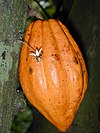Fudge

Multi tool use
 Fruit fudge | |
| Type | Confectionery |
|---|---|
| Serving temperature | Room temperature |
| Main ingredients | Sugar, butter, milk |
| Variations | Multiple |
Food energy (per serving) | a 100 gram serving may have over 450 calories kcal |
| |
Fudge is a type of sugar candy that is made by mixing sugar, butter and milk, heating it to the soft-ball stage at 240 °F (116 °C), and then beating the mixture while it cools so that it acquires a smooth, creamy consistency. Fruits, nuts, chocolate, caramel, candies, sweets and other flavors are sometimes added either inside or on top. A recent trend has been to create novel flavors of fudge, giving vibrant visual appeal at the same time.
Fudge is often bought as a gift from a gift shop in tourist areas and attractions.
Contents
1 History
2 Chemistry
3 Hot fudge
4 See also
5 Notes
6 References
7 External links
History
In a letter written in 1921 by Emelyn Battersby Hartridge, she recounts the purchasing of a box of fudge for 40 cents a pound in 1886 in Baltimore, Maryland. A student at Vassar College in Poughkeepsie, New York, she claimed to have introduced it there in 1888 by selling her own 30 lb (14 kg) batch.[1][2] The diary of another student mentions making "fudges" in 1892.[3] An 1893 letter from another Vassar College student describes "fudges" as containing sugar, chocolate, milk and butter.[4] A recipe for "Fudges at Vassar" was printed in The Sun in 1895.[5] Despite describing the confections as "Vassar chocolates", the recipe given comprises sugar, milk, butter and vanilla extract.
Word of this popular confectionery spread to other women's colleges. For example, Wellesley College and Smith College have their own versions of a fudge recipe dating from the late 19th or early 20th century.[6]
Fudge-making evolved a variety of flavors and additives as it grew beyond its popularity at colleges.
Chemistry

Fudge being cooled and shaped on a marble slab
In forming a fondant, it is not easy to keep all vibrations and seed crystals from causing rapid crystallization into large crystals. Consequently, milkfat and corn syrup are often added. Corn syrup contains glucose, fructose (monosaccharides), and maltose (disaccharide). These sugars interact with sucrose molecules. They help prevent premature crystallization by inhibiting sucrose crystal contact. The fat also helps inhibit rapid crystallization. Controlling the crystallization of the supersaturated sugar solution is the key to making smooth fudge. Initiation of crystals before the desired time will result in fudge with fewer, larger sugar grains. The final texture would then be grainy, a quality normally indicative of low-quality fudge.
One of the most important attributes of fudge is its texture. The end-point temperature separates hard caramel from fudge. The higher the peak temperature, the more sugar is dissolved and the more water is evaporated, resulting in a higher sugar-to-water ratio. Before the availability of cheap and accurate thermometers, cooks would use the ice water test, also known as the cold water test, to determine the saturation of the confection. Fudge is made at the "soft ball" stage, which varies by altitude and ambient humidity from 235 °F (113 °C) to 240 °F (116 °C). The heated fudge is sometimes poured onto a marble slab to be cooled and shaped.[7]
Hot fudge
Hot fudge in the United States and Canada is usually considered to be a chocolate product often used as a topping for ice cream in a heated form, particularly sundaes and parfaits. It may also occasionally be used as a topping for s'mores. It is a thick, chocolate-flavored syrup (flavored with natural or artificial flavorings) similar in flavor and texture to chocolate fudge, except melted so that it can be poured.
See also

Assorted fudges
- Toffee
Clotted cream – an ingredient used to make traditional hand-made fudge that is frequently used in the UK and Ireland.- Condensed milk
- Fudge cookie
- Chocolate brownie
Praline – a confection using similar flavors as original fudge
Scots tablet – Scottish confection with similar recipe
Krówki – Polish confection similar to fudge
Penuche – a type of fudge typically found in New England and the Southern United States
Knäck – a Swedish toffee confection
Barfi – an Indian type of fudge made from cooking milk and sugar into fudge consistency, additions include coconut, carrot, or made from nuts
Notes
^ Benning, Lee Edwards (1990). Oh Fudge!: A Celebration of America's Favorite Candy (1993 ed.). New York: Owl Books. pp. 3–18. ISBN 0-8050-2546-4..mw-parser-output cite.citationfont-style:inherit.mw-parser-output .citation qquotes:"""""""'""'".mw-parser-output .citation .cs1-lock-free abackground:url("//upload.wikimedia.org/wikipedia/commons/thumb/6/65/Lock-green.svg/9px-Lock-green.svg.png")no-repeat;background-position:right .1em center.mw-parser-output .citation .cs1-lock-limited a,.mw-parser-output .citation .cs1-lock-registration abackground:url("//upload.wikimedia.org/wikipedia/commons/thumb/d/d6/Lock-gray-alt-2.svg/9px-Lock-gray-alt-2.svg.png")no-repeat;background-position:right .1em center.mw-parser-output .citation .cs1-lock-subscription abackground:url("//upload.wikimedia.org/wikipedia/commons/thumb/a/aa/Lock-red-alt-2.svg/9px-Lock-red-alt-2.svg.png")no-repeat;background-position:right .1em center.mw-parser-output .cs1-subscription,.mw-parser-output .cs1-registrationcolor:#555.mw-parser-output .cs1-subscription span,.mw-parser-output .cs1-registration spanborder-bottom:1px dotted;cursor:help.mw-parser-output .cs1-ws-icon abackground:url("//upload.wikimedia.org/wikipedia/commons/thumb/4/4c/Wikisource-logo.svg/12px-Wikisource-logo.svg.png")no-repeat;background-position:right .1em center.mw-parser-output code.cs1-codecolor:inherit;background:inherit;border:inherit;padding:inherit.mw-parser-output .cs1-hidden-errordisplay:none;font-size:100%.mw-parser-output .cs1-visible-errorfont-size:100%.mw-parser-output .cs1-maintdisplay:none;color:#33aa33;margin-left:0.3em.mw-parser-output .cs1-subscription,.mw-parser-output .cs1-registration,.mw-parser-output .cs1-formatfont-size:95%.mw-parser-output .cs1-kern-left,.mw-parser-output .cs1-kern-wl-leftpadding-left:0.2em.mw-parser-output .cs1-kern-right,.mw-parser-output .cs1-kern-wl-rightpadding-right:0.2em
^ Quinion, Michael. "Fudge". World Wide Words. Retrieved 12 January 2018.
^ Martin, Elma (22 December 1892). "Diary". Vassar College Digital Library. Poughkeepsie, New York, New York. p. 33. Retrieved 12 January 2018.
^ Mansfield, Adelaide (12 November 1893). "Letter". Vassar College Digital Library. Poughkeepsie, New York, USA. p. 6. Retrieved 12 January 2018.
^ "Fudges at Vassar". The Sun. New York, New York, USA. 23 December 1894. p. 1, col. 4. Retrieved 11 January 2018.
^ Werner, Edgar S. (1915). Werner's Readings and Recitations. 54. Edgar S. Werner and Co. p. 159. ISBN 1-145-32274-3.
^ Reed, Anne (13 April 2016). "Tradition lives at Gulf Coast Fudge Co., North Fort Myers". news-press.com. Retrieved 18 August 2016.
References
.mw-parser-output .refbeginfont-size:90%;margin-bottom:0.5em.mw-parser-output .refbegin-hanging-indents>ullist-style-type:none;margin-left:0.mw-parser-output .refbegin-hanging-indents>ul>li,.mw-parser-output .refbegin-hanging-indents>dl>ddmargin-left:0;padding-left:3.2em;text-indent:-3.2em;list-style:none.mw-parser-output .refbegin-100font-size:100%
Jones, Charlotte Foltz (1991). Mistakes That Worked. Doubleday. ISBN 0-385-26246-9.
External links
Wikibooks Cookbook has a recipe/module on
|
| Wikimedia Commons has media related to Fudge. |
Science of candy: Fudge, Exploratorium
aXAX9,7QOGqNxCM,r M ANzM4YrCzakE9qs58KXl
